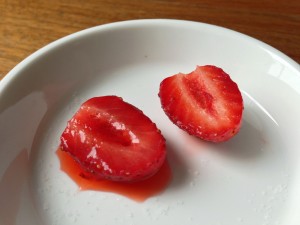Early summer brings lots of fresh strawberries, and I’ve been happily bringing home a quart or two from the greenmarket over the past few weeks. Strawberries fall into the category of “non-climacteric” fruits. This means that unlike bananas or tomatoes, they don’t continue to ripen after harvest. They’re at their peak when you pick them, and then it’s use them or lose them. To make things worse, they’re also thin-skinned, which allows mold and bacteria an easy foothold. Leave a pint of strawberries sitting on your kitchen counter on a muggy summer day and you can easily come back a few hours later to find them mushy and covered in fuzz!
So what to do with your berries? Personally I like to macerate them. (It’s ok, I’ll wait for your 12 year old self to stop chuckling : ) Maceration is the term for breaking something down in liquid. Much like marinating meat, maceration will soften the fruit by breaking down cell walls, and can also impart flavor, either into the fruit, or from the fruit into the liquid.
With strawberries, you’ll want to start by washing and hulling them (removing the stem part), and then slice them into pieces so more surface area is exposed. Then you’ve got some options. The most common thing to do is simply sprinkle them with sugar. Sugar is hygroscopic, meaning it attracts water. As the liquid is drawn out of the fruit, its cell walls will start collapsing, releasing further liquid until soon your berries have created their own syrup. You can also soak them in alcohol, or in acid like lemon juice. Personally, given how sweet strawberries are already, I prefer using balsamic vinegar, which has both sugar and acid in it, and brings out the fresh strawberry flavor while adding some complexity of its own.
I recently did a taste test and here are some different options you could try:
- Honey or maple syrup: more interesting variations on plain sugar
- Balsamic vinegar: Keeps the bright strawberry flavor but adds some notes of dark fruit or prunes, cuts the sweetness a bit. Even better when some chopped basil or mint is mixed in
- Orange liqueur or rum: If you’re going to go this route, be sure to add sugar or else it will be too harsh. The exception was elderflower liqueur, which is naturally sweet, and would complement strawberries pretty well in a dessert
- Lemon/lime: sweet-tart and bright, tastes like another kind of fruit entirely. The lime version had a sour candy taste like Smarties.
- Soy sauce – a salty/sweet combination that your tongue wasn’t expecting. Definitely not for everyone, but it could be a fun surprise if worked into the right dish
In general it will take about half an hour for the magic to happen. At that point, you can top the macerated berries with whipped cream, pour them over ice cream with their syrup, or make a shortcake. You can also strain them out of the liquid and cook with them, since having some of the liquid removed already makes for a less-soggy pie. The season for fresh strawberries is coming to a close here in Brooklyn, but this will also work with raspberries, blueberries, blackberries, and the other fruits of summer.

Speak Your Mind